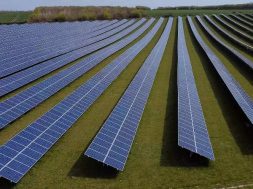
Rolling out solar cells: German-Danish project researches flexible organic PV technologies
Solar PV cells as thin as foil, and so flexible that they can be rolled out over various large surfaces such as house and vehicle roofs or glass fronts – that is one of the long-term goals of a German-Danish research project that is starting now.
Those involved in the “RollFlex Innovation Project Centre” include the University of Southern Denmark (SDU), where the project is headquartered, Kiel University (CAU), the CAU-based start-up FUMT R&D Functional Materials GmbH, the Danish company Stensborg A/S, as well as numerous German and Danish network partners.
The development of organic energy technologies has already been researched for several years, since solar cells and LEDs made of organic materials have great potential regarding energy efficiency and sustainable power generation.
The reason for this is their completely new properties in comparison with traditional silicon cells: mechanical flexibility, light weight, low costs, as well as semi-transparency. In this way, innovative applications for the future could be possible, right up to smart windows or wearable technologies in clothing.
Efficient and cheap solar cells
With the trans-regional research project “RollFlex,” German and Danish scientists want to make great strides in the development of organic energy technology. For this purpose, the RollFlex Innovation Project Centre is being created in the Danish town of Sonderborg, as a laboratory for researching and developing roll-to-roll printing presses.
Using this process, materials should be printed onto large areas of thin substrates such as flexible glass or plastic films. In the end, they should also include electrical components such as flexible electronics, organic light emitting diodes (OLEDS) and solar cells. They could then be used to develop products for areas like lighting, displays or photovoltaic applications.
In the cleanroom of the CAU, Kiel scientists investigate nano and micro structures, to increase the efficiency of organic solar cells and OLEDs.
“Through the RollFlex project, we can bundle excellent competencies from the region in the areas of roll-to-roll printing and optimisation of organic components. In building up a strong network between southern Denmark and northern Germany, we hope to make energy technology significantly more efficient in the long term. Kiel Nano Laboratory’s cleanroom makes an important contribution here,” said Martina Gerken, Professor at the Institute of Electrical Engineering and Information Technology and the project leader at the CAU.
Kiel team produces nano and micro structures in cleanroom
The Kiel partners in the project research the central principles of the new solar technology: by using small components they want to demonstrate how micro and nano structures can increase the efficiency of flexible solar cells. For this purpose, electrical engineers from the CAU will initially investigate how the individual structures influence the luminosity of OLEDs.
“Because the principle of OLEDs is similar to how solar cells work – just in reverse,” explained the head of the laboratory, Dr. Sabrina Jahns. “To transfer the results which we obtain from the small centimetre-sized OLEDs and organic solar cells to large roll-out components – that is the greatest challenge for our research project.”
The small size of the components makes it relatively easy to experiment with numerous variants. In this way, the scientists want to identify the optimal configuration for the solar cells which are to be produced. In their optical laboratory, the scientists from Kiel irradiate the OLEDs with lasers, to investigate the effectiveness of the applied micro and nano structures. The small solar cells and OLEDs are developed in the cleanroom laboratory in Kiel, which offers ideal conditions for producing sensitive prototypes without impurities.
The scientists at the CAU are working in close cooperation with FUMT R&D Functional Materials GmbH, a start-up founded at Kiel University to develop functional materials. In particular, special sheets with nano particles are produced for the project there. They should protect the OLEDs – and later also the organic solar cells – from humidity and oxygen.
“This protective layer is particularly important for organic technologies. It prevents chemical processes which can shorten the lifespan of solar cells and OLEDs,” explained Dr. Ala Cojocaru, project leader at FUMT.
“We have already gained experience with foils from another research project, for which we applied a functional layer by means of a roll-to-roll process. For us, it is very interesting to see how our materials can be used to produce energy,” added CEO Hartmut Schmidt-Niepenberg.
















